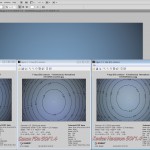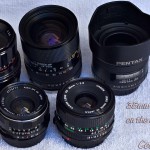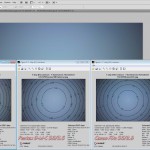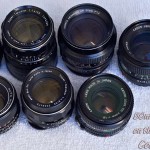Grand Canyon North Rim photos and Valley of Fire State Park pics
These Grand Canyon and Valley of Fire photos were shot with the Sony a7R and a Pentax-M 28mm f/3.5 lens.
Lighting conditions at the Grand Canyon North Rim were mostly flat and gray, with brief glimpses of sunlight at sunrise and sunset, which made photo processing difficult. The views from Cape Royal road were spectacular. Way off in the distance, you can see the Colorado River making a loop around a large sandy area. That area is known as the Unkar Delta. Walhalla Overlook is the view in the photo that has the big rock wall on the right side.
Bright Angel Point Trail is a short walk from the Grand Canyon Lodge, and it provides some great views of Bright Angel Canyon. The three big peaks you’ll see there have Hindu names; Zoroaster Temple, Deva Temple, and Brahma Temple.
The Valley of Fire is a state park in Nevada, just outside of Las Vegas. Do a little hiking with your camera, and you might be rewarded with some shots of the resident mountain goats.
This is one trip that you’ll want to put on your bucket list!
Dan Euritt
50mm prime lens comparison, shot on Sony a7R, first round
This first round of 50mm SLR camera lens testing will cover some of the fast f/1.4 glass. Four lenses total, all 50/1.4; Pentax Super Takumar, Canon FDn, Konica Hexanon AR, and SMC Pentax.
Here are the vignetting test results on the top three finishers, at f/1.4. They were all pretty close.
Super Takumar: -2.84(f-stops)
Canon FDn: -2.7(f-stops)
Konica Hexanon: -2.79(f-stops)
The Pentax Super Takumar had a slightly slower shutter speed, but all RAW files were adjusted to be at roughly the same exposure, before processing. Only four of the lenses in the photo below have been tested so far, the slow glass will be covered later.

50mm lens Vignetting test: Super Takumar, Canon FDn, Konica Hexanon AR, Pentax SMC Takumar, on the Sony a7R
Ease of focus at long distances: The 50mm focal length, at this subject distance, is close enough to be using the second stage of Sony a7R EVF magnification. The “5610” street number on the back of the building is the focus point, as usual. All of these lenses worked fairly well for focusing, although the Super Takumar was probably better at focusing than the Canon FDn was.
Lens contrast: *Wide open* There was significant veiling haze over the Super Takumar, and to a slightly lesser extent, the Konica Hexanon AR, which made it hard to see much contrast at all. One point each for the Canon FDn and the SMC Takumar, but not by much. *f/8* It’s difficult to make a solid judgement here. There are different exposures and different lighting conditions; the SMC Takumar has this yellowish earthy tone to it, possibly due to a radioactive element, that is distracting. You’ll have to decide for yourself. More on the radioactive elements at this link; note that the Konica Hexanon AR 50/1.4 that was tested here has the f/16 max aperture/green AE markings that are on this list: http://camerapedia.wikia.com/wiki/Radioactive_lenses
Sides of the images: *Wide open* f/1.4 makes picking the winner a bit easier. The SMC Takumar and the Konica Hexanon both go down hard here, they appear to have field curvature issues on the sides, so they are out for full frame use. It looks like it might be a possible lens design issue, so you may not find relief in different copies of the same design. Of the two remaining lenses, the Canon FDn is the strongest of the four on the left side, but it is soft on the right side. Two points for the Super Takumar, and one point for the Canon FDn, on the hope that a different copy doesn’t have the same right-side defect.
Center of the images: *wide open* The Super Takumar 50/1.4 beats the Canon FDn 50/1.4, one point; see the “5617” street number, on the front of the building, second street back from the camera, upper center of the image. The question here is whether or not the Canon lens is perfectly focused. *f/8* Things are a lot more competitive, you be the judge.
Summary: The Super Takumar moves forward, but with reservations about whether or not the left side is as good as that model of lens actually gets. The slightly soft right side of the Canon lens makes one wonder what a perfect copy of it would look like. It has less veiling glow than the Super Tak does wide open, so the potential is there.
**Here are the test images, they are 21-29mb in size, **be sure and view at 100% size**:
Dan Euritt
35mm prime lens comparison shootout, on the Sony a7R, first round
This is the first round of 35mm lens comparison testing, shot on the Sony a7R mirrorless camera. There are four 35mm SLR prime lenses here, and one 35-80mm zoom, tested at 35mm. Testing at the usual landscape distances was done at f/2.8-3.5, and at f/8. This is the longest focal length tested so far, and it comes with high hopes that the field curvature issues seen in previous rounds would be a thing of the past.
The vignetting results were as follows:
Pentax FA35, at f/2.0: 1/50th, -2.71(f-stops)
S-M-C Takumar, at f/3.5: 1/15th, -2.91(f-stops)
Canon FDn, at f/2.8: 1/30th, -2.99(f-stops)
It seemed like the FA35 corners should have been brighter than -2.71, but the test results were consistent even after re-testing.

35mm lens testing, CanonFDn, Promatic, Pentax FA35, Pentax S-M-C Takumar, and the 35-80 Tamron SP zoom lenses.

35mm lens vignetting test, on the CanonFDn, Promatic, Pentax FA35, Pentax S-M-C Takumar, and the 35-80 Tamron SP zoom lenses.
Ease of focus at long distances: Pentax FA35/2.0 all the way, for 2 points. It’s hard to imagine that an autofocus lens used in manual mode could top all of the competition, but it did. At the first stage of a7R magnification, the area of focus peaking was narrow and specific, and the focus ring was adequate. The Canon FDn just didn’t cut it here; the focus peaking area was too wide. The Tamron SP zoom felt like it was nearly a stop darker. Both it and the classic Pentax SMC Takumar 35/3.5 were tough to use wide open. Unfortunately the standard “5610” street number on the back of the building was in shadow during the test period, so it wasn’t clearly visible at full magnification, on any lens. Hence the need for focus peaking and partial magnification. The old Promatic 35/2.8 lens had radically different focus points at f/2.8 and f/8; wide open it was barely in focus, at it’s focus stop on the ring, but at f/8, it had plenty of room.
Lens contrast: The Pentax FA35/2.0 and the Canon FDn 35/2.8 both look good, 1 point each, but the superiority of the FA35 with focus peaking could work in its favor. The diminutive Pentax Super-Multi-Coated Takumar 35/3.5 looked flat, but it appeared to be shot at a slightly higher exposure, which could have been a factor.
Sides of the images: *Wide open*: The Promatic 35/2.8 failed miserably, it’s gone. The Takumar 35/3.5 was weak on the outer extremes, so it barely failed as well. The Tamron SP 35-80mm lens had out of focus areas on the far left, and in a wide vertical swath on the right side as well, so it’s out due to defects. That left the Pentax FA35/2.0, which was outstanding on the right side at f/2.8, but weak on the left side, and the Canon FDn 35/2.8; you judge. *f/8*: Everything recovered to some extent, with the exception of the left side on the Canon Fdn 35/2.8, which doesn’t look much better than it did at f/2.8. The Super-Multi-Coated Takumar 35/3.5 is usable, but generally softer on the sides than it’s FA35/2.0 brethren.
Center of the images: Pentax FA35/2.0 squeaks by the best of the competition, the Canon FDn 35/2.8; 1 point.
Summary: If one of these lenses wasn’t weak on the side(s), it either couldn’t be focused well, or it had field curvature issues. Overall, it’s a weak field. However, since previous tests were judged only at F/8, that’s what will be used here; the Pentax FA35/2.0 moves forward into the next round.
Here are the test images, they are 21-24mb in size, **be sure and view at 100% size**:
f/2.8-3.5:
https://www.codectest.com/images/35mmlenstest-F28-CanonFDnPromaticPentaxFA35PentaxSMCtakTamronSPzoom.jpg
Dan Euritt

































